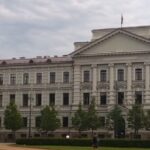
Standing in the heart of Vilnius, the Genocide Museum (Museum of Occupations and Freedom Fights) is a haunting reminder of Lithuania’s turbulent twentieth-century history. Housed within the former KGB headquarters, this effective corporation exposes the brutal Soviet and Nazi regimes that terrorized the state. Through chilling revelations, prisoner testimonies, and preserved execution chambers, the museum forces visitors to confront the horrors of occupation, resistance, and survival.
In this in-depth guide, we’ll explore the Genocide Museum Vilnius, its historical significance, must-see exhibits, and why it remains a vital site for know-how Lithuania beyond.
A Brief History: Why the Genocide Museum Exists
Lithuania experienced devastating occupations in the 20th century:
- The Nazi business (1941–1944) -The Holocaust reduced the Jewish population of Lithuania by more than 90% of the murder in massacres such as Pomeranian (Ponary).
- Soviet activities (1940–1941, 1944–1991) -Susser fulfilled, imprisoned, or deported by the USSR three hundred 000 Lithuanians to Siberian Gulags.
The museum’s building itself is a historic artifact—it served due to the fact the KGB headquarters from 1940 to 1991, where interrogations, torture, and executions took place. After Lithuania regained independence, the internet web page was converted into a memorial and museum in 1992 to honor sufferers and educate destiny generations.
Inside the Museum: Key Exhibits & What to See
1. The KGB Prison Cells
The basement holds the most harrowing phase—the authentic prison cells where detainees have been held in freezing, cramped situations. Visitors can see:
- Solitary confinement cells (some pitch-black for sensory deprivation)
- Execution chamber (where prisoners had been shot)
- Prisoner graffiti (desperate messages carved into walls)
2. Soviet Repression
- Deportation statistics – Lists of households sent to Siberia
- Personal assets – Suitcases, letters, and toys from deportees
- Gulag survivor tales – Audio recordings of survivors
Three. Lithuanian resistance movement
Despite Soviet oppression, Lithuanian people fought back. The museum highlights:
- Forest Brothers (Partisan Fighters) – Guerrilla warriors who resisted Soviet rule into the Fifties
- Clandestine press
4. Holocaust Memorial Section
While the museum on the whole makes a speciality of Soviet crimes, it also acknowledges the Nazi genocide of Lithuanian Jews, with:
- Photos from Vilnius Ghetto
- Stories of Righteous Among the Nations (Lithuanians who saved Jews)
Visitor Information: How to Visit the Genocide Museum Vilnius
Location
Address: Aukų g.2a, Villnius 01400, Lithuania
Inauguration Time: Tuesday -Sunday, 10 AM -6 PM (closed Monday)
Admission Fee: ~€5 (Discounts for college kids/seniors)
Guided Tours
For deeper insight, English-guided excursions (€30–€50 in keeping with the group) are available, providing:
Detailed stories of prisoners and resistance warring parties
Access to restrained areas (just like the KGB officials’ places of work)
Holocaust -Setts nearby
- Pomeranian (Ponary) Memorial – where 70,000 Jews were massacred (20 minutes from Vilnius)
- Wilna Gone Jewish State Museum – dedicated to Jewish heritage from Lithuania
Why This Museum Matters Today
The Genocide Museum Vilnius is not just much record—it’s a caution in opposition to tyranny. Key training includes:
- The price of freedom – Lithuania lost a 3rd of its population to war and deportations.
- The dangers of propaganda – Soviet and Nazi regimes manipulated facts to justify atrocities.
- The resilience of resistance – Even in darkness, Lithuanians fought for independence.
Controversies & Debates
Some critics claim that the museum also increased Soviet crimes, even to reduce Lithuanian cooperation in Holocaust.However, recent updates have brought extra Holocaust context, aiming for a balanced narrative.
Final Thoughts: A Must-Visit for History & Human Rights
The Genocide Museum Vilnius is a harrowing but vital enjoy for anyone travelling Lithuania. More than only a collection of artifacts, it’s a testimony to human suffering, braveness, and the fight for liberty.
Will you visit? This museum demands that we bear in mind the past—so history’s darkest chapters are never repeated.







